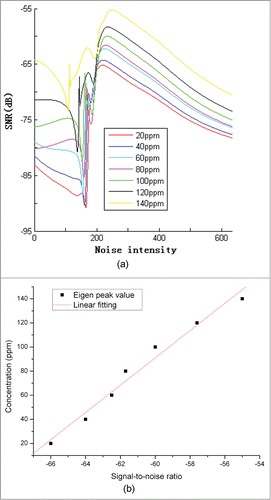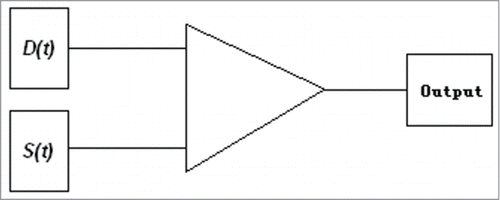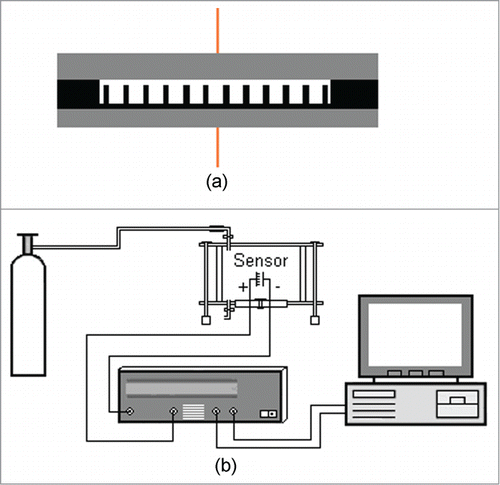 ?Mathematical formulae have been encoded as MathML and are displayed in this HTML version using MathJax in order to improve their display. Uncheck the box to turn MathJax off. This feature requires Javascript. Click on a formula to zoom.
?Mathematical formulae have been encoded as MathML and are displayed in this HTML version using MathJax in order to improve their display. Uncheck the box to turn MathJax off. This feature requires Javascript. Click on a formula to zoom.Abstract
In this paper, a novel benzene quantitative analysis method utilizing miniaturized metal ionization gas sensor and non-linear bistable dynamic system was investigated. Al plate anodic gas-ionization sensor was installed for electrical current-voltage data measurement. Measurement data was analyzed by non-linear bistable dynamics system. Results demonstrated that this method realized benzene concentration quantitative determination. This method is promising in laboratory safety management in benzene leak detection.
Introduction
Benzene, an important chemical widely utilized in chemical engineering industries and university laboratories, is a kind of odorous hazardous organic gas.Citation1 It presents a very strong smell. The permissible maximum concentration for human being is 6 mg/m3. It is dangerous to breathe benzene at 20000 ppm for over 5 min. So study of a novel reliable gas sensor for benzene detection is of great importance.Citation2 Many researchers have developed various sensing systems for benzene detection.Citation3 Many studies have been conducted to improve sensor's functions utilizing catalytic effect of SnO2.Citation4
Non-linear bistable dynamic model was first proposed by Italy scientist in 1981 for the earth ice age regular pattern explanation.Citation5 This model has been widely utilized in signal analysis, biological exploration, neural computation, and etc.Citation6,7 Under some certain optimal condition, an additional dose of external white noise activate the performance of systematic output by eliminating the internal noise within the system.Citation8 When used properly, the non-linear dynamic system presents an exciting improvement in coherence output, which helps to fulfill the applications of non-linear dynamic system as a mathematical tool in lots of scientific research areas.Citation9,10
A novel benzene quantitative determination method using miniaturized metal ionization gas sensor and non-linear double-well dynamic system was investigated in this research. Al plate anodic gas-ionization sensor was installed for electrical current-voltage data achievement. Measurement data was analyzed by non-linear double-well dynamics system. Results demonstrated that the proposed method fulfilled benzene concentration quantitative determination. This method is promising in laboratory safety management in benzene leak testing.
Results and Discussion
Bistable dynamics system
Non-linear bistable dynamics system coherence index principle calculating block was displayed in . Sensor measurement data recorded by computer was input into the bistable dynamic model together with the external white noise. Then coherence index information was calculated in non-linear bistable dynamics system, and displayed on the screen.
Benzene concentration determination results
displayed benzene concentration determination results. The signal-to-noise ratio index curves arrived at their eigen peaks at noise intensity of about 270. Benzene in different concentrations could be distinguished by signal-to-noise ratio peak maximums. The higher gas concentrations possessed higher signal-to-noise ratio peak maximums. displayed the concentration grads more clearly. The maximums of the signal-to-noise ratio peak peaks increased with the increase of the benzene concentrations. Signal-to-noise ratio maximums provided us a useful gas concentration quantitative analysis way for benzene.
Figure 2. Detecting results of benzene: (a) signal-to-noise ratio curve; (b) benzene concentration determination model.

For determination of benzene concentrations, maximal values of coherence index eigen peak values in . Signal-to-noise ratio peak maximums were selected to develop benzene concentration determination model. In , linear fitting regression between signal-to-noise ratio eigen peak maximal values and benzene concentrations was made, and displayed in Equation Equation(1)(1)
(1) . Equation Equation(1)
(1)
(1) was used to conduct the benzene concentration prediction.
(1)
(1)
Methods
Sensor and experimental setup
Measurements in this study were conducted using anodic multi-walled carbon nanotube/Al plate ionization gas sensor. Its structure was displayed in . The gas-ionization sensor included multi-walled carbon nanotube electrode, Al plate electrode, and polyimide thin membrane. Polyimide insulation membrane was used between the multi-walled carbon nanotube electrode and the Al electrode. Interelectrode interval could be enlarged or reduced by changing the thickness of polyimide membrane. The range of 2 electrodes was 2cm×4cm, and the effective range between multi-walled carbon nanotube electrode and Al plate electrode was 1.8cm×2cm. Measurement system was displayed in . Gas flowed into gas chamber to get in touch with ionization gas sensor. The peripheral circuit system increased the interelectrode voltage, and recorded the discharge current and the electrical voltage, which were transmitted into the desktop via USB port for the next analysis.
Non-linear bistable dynamics model
Non-linear bistable dynamics model has been tremendously paid attention in fields.Citation5 Non-linear bistable dynamics model possesses 3 basic elements: a bistable model, a weak coherent input, and outer stimulation:(2)
(2)
is a outer stimulation.
is the input signal amplitude and
is the modulation frequency, and
is stimulation intensity. The most frequently used quantifiers for non-linear bistable dynamics model are the spectral amplification
and the output coherence index. Here we adopt coherence index method, which leads the following definition:
(3)
(3)
is the signal power spectral density, and
is outer stimulation in signal frequency range.Citation6-8
Experiments
7 concentrations of benzene (20 ppm, 40 ppm, 60 ppm, 80 ppm, 100 ppm, 120 ppm, and 140 ppm) experiments were achieved to obtain discharge current and the electrical voltage. Then the discharge current and the electrical voltage data were input into the non-linear bistable dynamics system block, and signal-to-noise ratio index was counted to output the experimental results. All the tests were all conducted under room temperature, 85% relative humidity, and no gas-flow.
Conclusions
In this research, benzene quantitative analysis using miniaturized anodic multi-walled carbon nanotube/Al plate ionization gas sensor and non-linear bistable dynamic system was proposed. Anodic multi-walled carbon nanotube/Al plate ionization gas sensor was used to obtain the discharge current and the electrical voltage data. Measurement data was processed by non-linear bistable dynamics system. Results displayed that the proposed model could quantitatively determine benzene concentrations. The method is promising in laboratory safety management in benzene leak detection.
Disclosure of Potential Conflicts of Interest
No potential conflicts of interest were disclosed.
References
- Xiaori F, Xiaogang G, Shuguang L, Zhouwei M, Minhui X, Xiang Z, Zhaofu Q, Qian S. Benzene depletion by Fe2+-catalyzed sodium percarbonate in aqueous solution. Chem Eng J 2015; 267: 25-33; http://dx.doi.org/10.1016/j.cej.2014.12.104
- Nirmal K, Dipankar D. A phenomenological use of benzene tip to probe aromaticity. Comput Theoret Chem 2015; 1060: 24-30; http://dx.doi.org/10.1016/j.comptc.2015.02.011
- Wen S, Shuangwu N, Chunhou Z. Development of cataluminescence sensor system for benzene and toluene determination. Sensors Actuat B Chem 2015; 209: 297-305; http://dx.doi.org/10.1016/j.snb.2014.11.093
- Vaishnav VS, Patel SG, Panchal JN. Development of ITO thin film sensor for detection of benzene. Sensors Actuat B Chem 2015; 209: 381-8; http://dx.doi.org/10.1016/j.snb.2014.07.037
- Benzi R, Sutera A, Vulpiana A. The mechanism of stochastic resonance. J Phys A 1981; 14: L453-6; http://dx.doi.org/10.1088/0305-4470/14/11/006
- Chapean-Blondeau F. Stochastic resonance at phase noise in signal transmission. Phys Rev E 2000; 61: 940-3; http://dx.doi.org/10.1103/PhysRevE.61.940
- Jung P, Hanggi P. Amplification of small signals via stochastic resonance. Phys Rev A 1991: 44: 8032-42; PMID:9905956; http://dx.doi.org/10.1103/PhysRevA.44.8032
- Wenning G, Obermayer K. Activity driven adaptive stochastic resonance. Phys Rev Lett 2003; 90: 120602_1-120602_4; PMID:12688861; http://dx.doi.org/10.1103/PhysRevLett.90.120602
- Nan W, Aiguo S. Parameter-induced logical stochastic resonance. Neurocomputing 2015; 155: 80-83; http://dx.doi.org/10.1016/j.neucom.2014.12.045
- Harmer GP, Davis BR, Abbott D. A review of stochastic resonance: circuits and measurement. IEEE Trans Instrument Measur 2002; 51: 299-309; http://dx.doi.org/10.1109/19.997828


